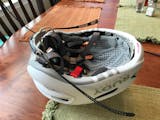Winter Sunglasses 101

Winter’s cold, dark, rainy, and cloudy days are still prime time for a good pair of winter glasses. For one, the sun spends most of its time lower in the sky, which actually increases your chances of looking directly into its harmful UV rays. And if your winter includes any snow, you’re well aware of the intense glare that bounces off that brilliant white backdrop and sizzles your cornea on a sunny day. But even on those cloudy, gray days, a good pair of winter sunglasses will be useful, helping you see contrasts and shadows easier, especially when your surroundings are covered in snow.
Best Sunglasses Tints for Winter
Whether you’re a snowboarder who spends time in the terrain park, a runner logging winter miles to train for a spring event, or a daily commuter just driving to work and back, the right lens tint will help you see everything with more clarity.
In general, brown or green tints lead the way in a wide breadth of winter applications and scenarios, environments offering heightened contrasts and increased depth perception (a key feature in flat-light conditions on the snow). Mirrored lenses in gold, blue, or silver/gray work best for snowsports, especially on sunny days. Since they block 100% of reflected light, they’ll give you a brighter, clearer field of vision.
Polarized or Mirrored Lenses?
Both polarized lenses and mirrored lenses eliminate glare, making it easy to see in icy and snowy conditions. Polarized lenses have long been the go-to lens for people who spend a lot of time in the water and on the snow. That’s due to polarization technology’s ability to prevent horizontal light waves from getting to your eyes. Instead of a reflective glare from water or snow or ice, you can see what’s actually there. Mirrored lenses reflect 100% of any reflected light, and the mirrored coating makes these lenses one of the most durable and scratch-resistant lenses you can find. This is why they appear in an abundance of ski goggles.
Which one’s right for you? It depends on your use case: Polarized lenses are ideal in a variety of situations, whereas mirrored lenses work best for outdoor pursuits on bright, sunny days in the snow.
Choosing the Right Sunglass Frames for Winter
There’s only one right answer here: Go with high-quality molded polymer frames, not metal. Metal frames may look great, but they get cold to the touch in freezing conditions. Frames made from bio-based polymer, such as Rudy Project’s Rilsan® Clear, feature durable, featherweight construction in any shape frame without the structural and design limitations of metal.
Find the Best Combination of Protection and (Air) Flow
Winter brings a unique set of protection challenges to your sunglass choice. To start, go with wrap-around lenses (think ski goggles and their curved lenses). These help mitigate any harsh reflections or low-angled sunlight from entering your field of vision from the sides. From there, the key is to maximize ventilation to keep your glasses from fogging up while still protecting your eyes from wind, rain, snow, or other irritants. The Rudy Project Agent Q frames and lenses do the trick thanks to their protection flexibility. Their wrap-around lens ensures a full field of vision protection, and a foam gasket sits on your face to form a protective barrier around your eyes. Adjustable nose bridges and snap-on side shields wrap your eyeballs in safety while still letting air flow through them.
And Now a Word About Photochromic Lenses for Winter
A strong case can be made for the convenience of photochromic lenses in winter, lenses that transition quickly from clear to tinted and back again. For morning or afternoon outdoor excursions that start or end in the dark, they do away with the need to carry multiple glasses or lenses. Not all that long ago, people were limited to gray lenses in this market. But Rudy Project’s ImpactX photochromic lenses come in red, brown, and purple tints that offer the deep contrast and clarity that traditional gray or black photochromic lenses never could.









